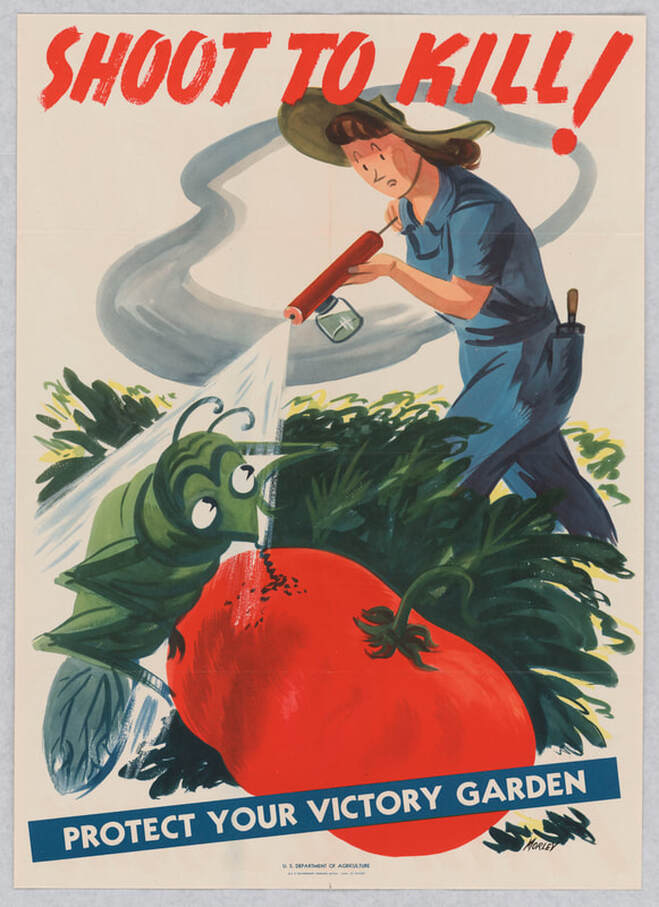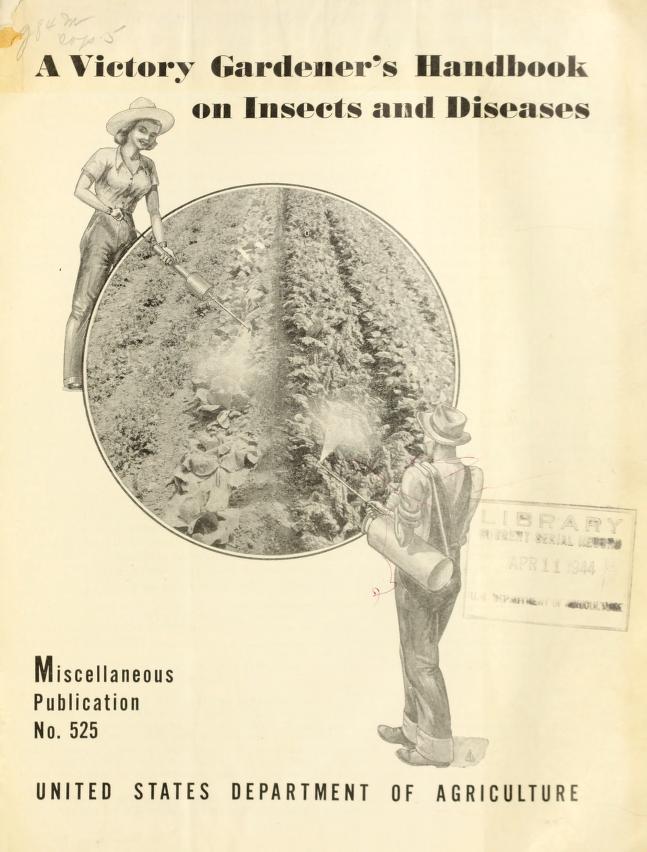|
When it comes to modern ideas about Victory Gardens, there's a lot of romanticism and rose-colored glasses. Hearkening back to a kinder, gentler time when everyone pulled together toward a common goal and had delicious, organic vegetables in their backyards while they did it. But the reality was often much different from our modern perceptions. This propaganda poster is a good example of that. "Shoot to kill!" it says - "Protect Your Victory Garden!" In it, a woman wearing blue coveralls and a wide-brimmed hat, a trowel in her back pocket, sprays pesticide on a large, green insect (a grasshopper?) taking a bite out of an enormous and perfectly red tomato. She is protecting her victory garden from the "fifth column" of insect predation. "The Fifth Column" was a term used in the United States to describe sabotage and rumor-mongering by foreign spies. In this instance, insects become the "fifth column" because the act of eating crops threatens wartime food supplies, and is therefore sabotage by a foreign enemy. The food supply had to be protected and maximized at all costs. Anxieties around food supplies, especially in the winter when commercially produced foods might be scarce, meant that victory gardens took on special urgency. For the first time in at least a generation, Americans were having to put up their own food to help them get through the winter. And making every quart count was only possible if the garden did well. Lots of militarized language was used in propaganda concerning food, but none as war-like as the battle against pests in the victory garden. The idea that gardening before the 1950s was all organic is a common misconception. Even prior to the First World War, farmers and even some gardeners were dusting their crops with Paris Green and London Purple. Paris Green was a bright green toxic crystalline salt made of copper and arsenic. London Purple was calcium arsenate - normally white, but also a byproduct of the aniline dye industry, and was therefore sometimes tinged purple. Along with arsenate of lead, another salt, these three were termed arsenical pesticides and were used often in agriculture. The arsenic in rice scare from a few years ago was likely due to elevated levels of arsenical pesticide residue in the soil. Especially since rice from California, which first began to be commercial produced in 1912, but was not widely available across the country until the 1960s. That late adoption of rice agriculture meant that production was not as exposed to arsenical pesticides as elsewhere in the U.S. In 1944, the USDA published "A Victory Gardener's Handbook of Insects and Diseases" that identified common pests and suggested remedies. Calcium arsenate and Paris green were recommended (albeit with warnings about arsenic residue), along with:
Although some people may have chosen not to purchase pesticides, likely due to expense more than concerns about poisoning, the emphasis on the danger pests posed to the general food supply continued. Hand atomizers, which is what the hand sprayer in the propaganda poster is called, were frequently depicted in print and even on film. Despite USDA warnings about application safety, no one is ever seen applying the highly toxic, aerosolized liquid pesticides with protective equipment. However, the science of the effects of exposure to toxic chemicals was not yet well-studied. DDT, invented in 1939, was deemed a miracle chemical and helped dramatically reduce diseases like malaria and water-borne bacteria that in previous wars had sometimes killed more soldiers than the conflict itself. Because soldiers faced no immediate effects, the chemical was deemed safe, and used everywhere from farms to a treatment for lice in children. But like the arsenical pesticides, the effect was cumulative, and it wasn't until Rachel Carson's 1962 Silent Spring that Americans began to wake up to the dangers of pesticides. The Food Historian blog is supported by patrons on Patreon! Patrons help keep blog posts like this one free and available to the public. Join us for awesome members-only content like free digitized cookbooks from my personal collection, e-newsletter, and even snail mail from time to time! Don't like Patreon? Join with an annual membership below, or just leave a tip! Join on Patreon or with an annual membership by June 30, 2020 and get a picnic history packet mailed to your door!
2 Comments
7/25/2022 01:54:19 pm
Trying to verify an obscure food history footnote. Is it true that some pubs in England during WWII would float a pinch of DDT to your drink to add a little bit of numbing spice.
Reply
Your comment will be posted after it is approved.
Leave a Reply. |
AuthorSarah Wassberg Johnson has an MA in Public History from the University at Albany and studies early 20th century food history. Archives
July 2024
Categories
All
|



 RSS Feed
RSS Feed